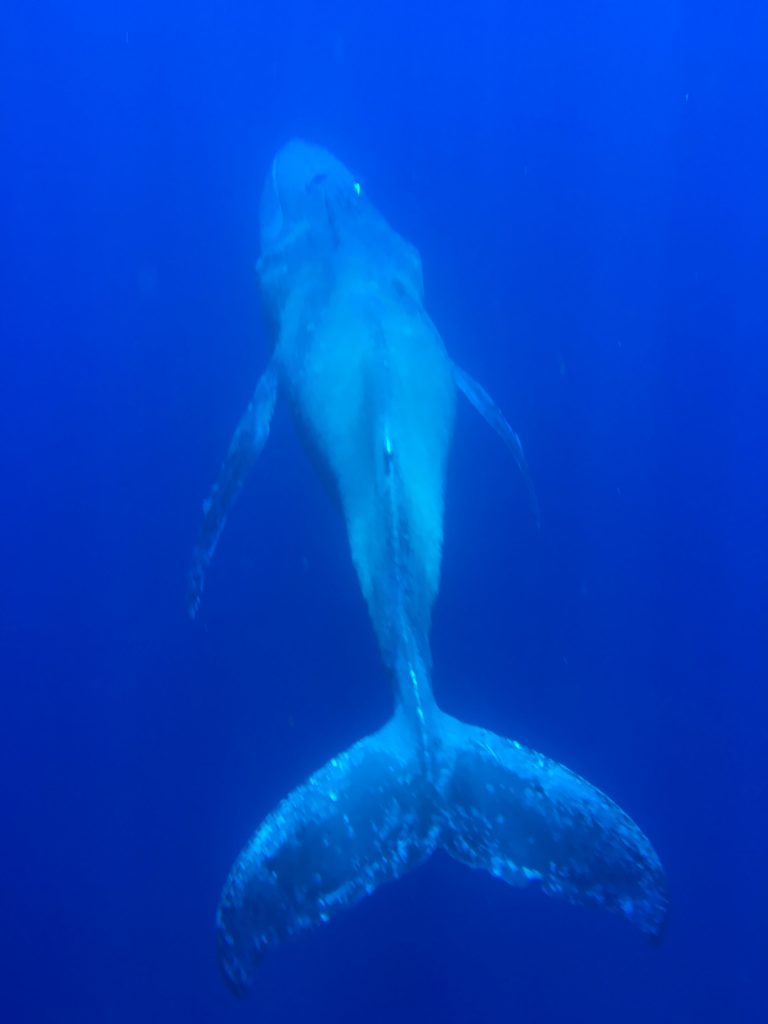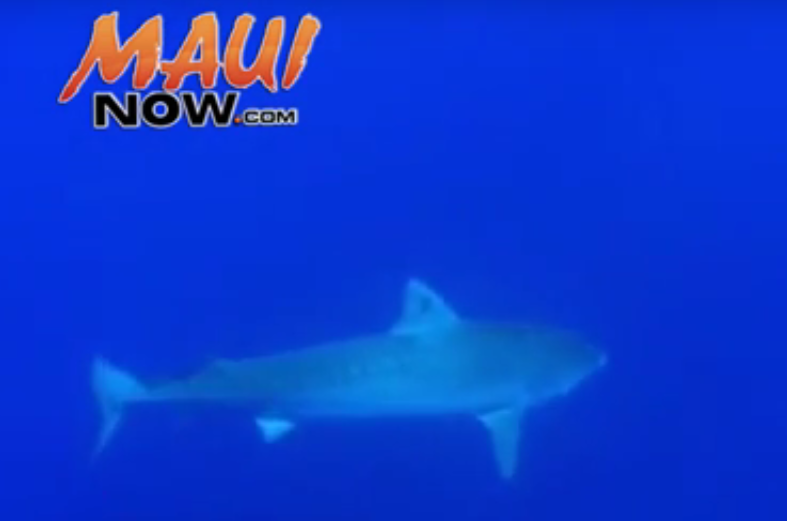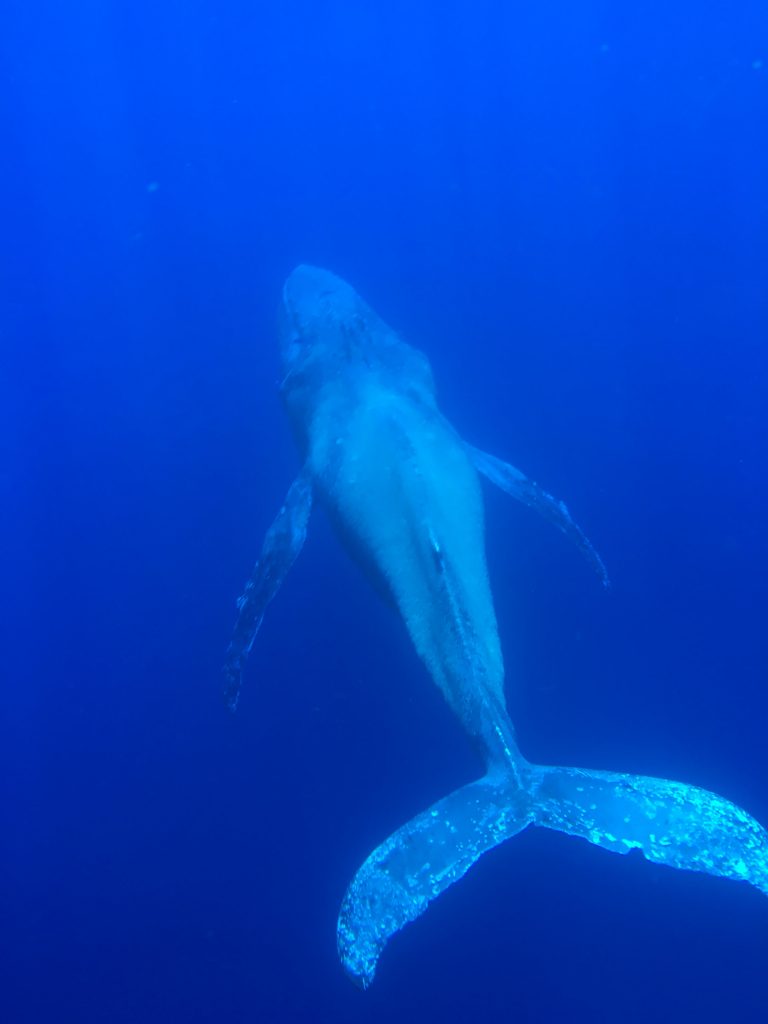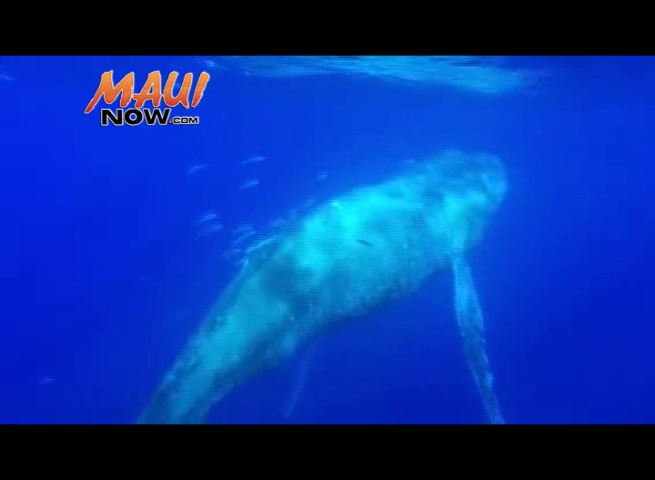VIDEO: Emaciated Humpback Whale Makes Premature Appearance, Tailed by Tiger Shark
VIDEO: Captain Hall (The Wiki Wahine, Ultimate Whale Watch), NOAA’s West Maui Response team (MMHSRP Permit #18786)
In an untimely appearance, a humpback whale was spotted in Maui waters off the coast of Lahaina on Thursday afternoon, Aug. 25, 2016, well ahead of the traditional whale season in Hawaiian waters.
Captain Ryan Hall with Ultimate Whale Watch and Snorkel was alerted to the sighting and responded to the incident as part of the West Maui Rapid Response team.

VIDEO: Captain Hall (The Wiki Wahine, Ultimate Whale Watch), NOAA’s West Maui Response team (MMHSRP Permit #18786)
According to Hall, the company donates it resources to assists NOAA Fisheries with large mammal entanglement and distress response efforts. Hall said Ed Lyman, NOAA’s Large Whale Entanglement Response Coordinator and Resource Protection Specialist with the Hawaiian Islands Humpback Whale National Marine Sanctuary, contacted him at around 3:30 p.m. to respond, stating that a Blue Hawaiian Helicopter pilot had spotted the whale about a short time earlier.
Hall, was cleaning up from a morning charter aboard the company’s The Wiki Wahine vessel at Lahaina Harbor when the report was made. “My boss and company owner Lee James and crew member Peter Columbo, met me at the harbor 10 minutes later and we set out to find this whale… unheard of at this time of year,” said Hall.
“It was a very unusual sighting. This is not considered whale season,” said Lyman in a phone interview this afternoon. “We have pretty much reports of whale sightings year round. If you go back 10-15 years, you’re going to get a report of whales in each month of the year, but your month of August is going to be like two or three over the last 10 years that I’m aware of,” said Lyman.
Executives with the Pacific Whale Foundation say this would be the first sighting of a humpback whale off the coast of Maui this year, “which is months ahead of when whales typically migrate from their northern summer feeding area to Hawaiʻi so that they can mate, calve and raise their young.”
The Superintendent with the HIHWNMS, noted that first sightings of humpback whales are typically in September or October, and that the whales are generally in Hawaiʻi from November through May.
Lyman said it’s unclear if it was an early or late sighting but said, “It’s pretty darn rare. We don’t know if this represents the first sighting of the year. I mean, I would lean against that in some ways considering the condition of the animal, it’s just as likely, if not more likely that this whale lingered from the last whale season, that it (may have) hung around, and it just happened to be spotted finally,” said Lyman.
“Maybe it was off shore a little bit, maybe trying to make a living off of the sea mounts around the islands. Maybe (there was) enough productivity, but then wasn’t doing well and finally started coming in to the protected waters and getting into poorer and poorer health. And that’s just a hypothesis. All we’re telling you is we don’t know if it was a late sighting or an early sighting,” said Lyman.
“After searching the area for a half hour or so we spotted the animal. Sadly the humpback was in bad shape–malnourished, emaciated and covered with parasites… compromised and wasting away,” said Hall.

VIDEO: Captain Hall (The Wiki Wahine, Ultimate Whale Watch), NOAA’s West Maui Response team (MMHSRP Permit #18786)
“Multiple large tiger sharks were following the animal. While no evidence of entanglement or a ship strike were observed, we can’t say for sure why this whale was in the shape it was in, or why it was in our waters, when it should still be up North on its feeding grounds,” Hall said.
The footage was shot from Hall’s iPhone which was in a life proof case and was held over the side of the boat as the animal made a close pass by the vessel.
“At least four sharks, likely all tigers, were trailing animal,” said Lyman. “While the animal is in poor shape, it does not appear that animal will succumb immediately,” he said. Authorities say the animal appeared to “still have energy, was quite mobile, had faculties (was observant of its environment, and the sharks were still standing off).”
“We couldn’t be sure what was wrong with the whale, only that something prevented this guy from feeding this year,” said Hall who noted there were no signs of injury or entanglement. “If there had been entangled line, Ed Lyman would have worked to free the whale. This animal was sick, so gathering photo and video data was all that could be done,” said Hall.

VIDEO: Captain Hall (The Wiki Wahine, Ultimate Whale Watch), NOAA’s West Maui Response team (MMHSRP Permit #18786)
According to Hall, there might be an attempt to take a biopsy or tissue sample. “That would be about the only other thing to do in this situation. It’s tough when we can’t help them. Sad for sure,” he said. “The response team’s first goal is to help. Second is to try and figure out what happened and try and learn from the situation,” said Hall.
A crew aboard the Trilogy 5 vessel also responded to the incident and Capt. Martin was able to relay critical information that the whale was not entangled.
If the whale is re-sighted today, Lyman said a biopsy may be done to gain more health indicators. “We would monitor the animal and then try to make a determination of what was the cause of its condition. It’s obviously in poor health. And we did that visually at least yesterday,” said Lyman who was assisted by the US Coast Guard in yesterday’s response effort.
The Pacific Whale Foundation also reported a sighting later in the day on Thursday evening by PWF Eco-Adventures vessel Ocean Quest.
Pacific Whale Foundation Founder Greg Kaufman noted that brief video captured of the whale on the surface, showed that it was encrusted with whale lice.
“The animal appears uninjured and not entangled. It could be sick, starving or suffering from an internal blunt trauma injury. Whale lice are naturally occurring on humpback whales but tend to proliferate when a whale becomes weak or sick. It’s akin to death by a thousand bites. We are sending our research team out first thing in the morning to see if they can track the whale’s whereabouts,” said Kaufman.

VIDEO: Captain Hall (The Wiki Wahine, Ultimate Whale Watch), NOAA’s West Maui Response team (MMHSRP Permit #18786)
“I have studied humpback whales in Hawaiʻi for nearly 40 years,” said Kaufman in a PWF press release. “To my recollection this is the earliest sighting of a humpback in Maui waters.” Previously, the earliest appearance recorded was on September 16 back in 2000, according to PWF records that date back to 1998. The majority of first sightings have taken place in October.
“Migrating whales do not arrive all at once,” said Kaufman. “They begin to appear off Maui’s coasts in autumn, with their numbers increasing through November and December.”
According to the PWF, at least 12,000 humpback whales are believed to migrate to Hawaiʻi each winter, with their rate increasing at 7% per year.
Under federal and state regulations, boaters and other water users are prohibited from approaching Humpback whales within 100 yards.
Captain Carlos and the crew of Ocean Quest were concluding a sunset dinner cruise at the time of the evening sighting about .75 miles off the coast of Olowalu.
Lyman said that when responding to incidents, the team tries to determine what happened and how bad off the animal is. “Maybe someday we can get to a point where–we’ve done this elsewhere is shoot antibiotics into the whale,” said Lyman. “There are things we can do, and then sometimes it’s just a matter of our hands are tied–we can’t help you help that individual, but by gaining information, and knowing what’s going on, we can better understand threats and help more animals in the future,” he said.
Lyman said that if the public sees the whale or any marine mammal in distress, they can call a 24-hour NOAA Fisheries hotline at (888) 256-9840.
Mariners are asked to keep a sharp lookout for this and other whales in distress, but not to approach closely or attempt to assist them. “While well-intentioned, freeing a 40-ton animal is extremely dangerous for the animal and the would-be rescuer,” said Lyman.
“Getting in the water is especially dangerous. People have been killed. As a result, only trained and well-equipped responders that are authorized under NOAA Fisheries’ Marine Mammal Health and Stranding Response Program are permitted to disentangle and assist whales and other marine mammals,” said Lyman.
If unable to call, please radio the US Coast Guard on VHF CH. 16 and they will relay the report.










